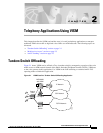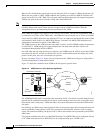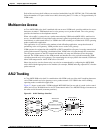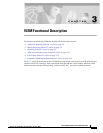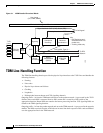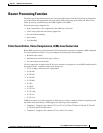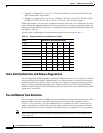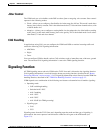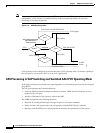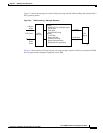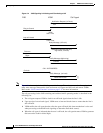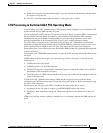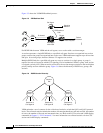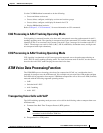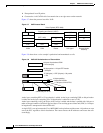
3-5
Cisco VISM Installation and Configuration Guide
Release 3.0, Part Number OL-2521-01 Rev. D0, June 2004
Chapter 3 VISM Functional Description
Signaling Function
Jitter Control
The VISM card uses voice buffers on the DSP to reduce jitter on outgoing voice streams. Jitter control
operates in the following modes:
• Fixed—Allows you to configure a fixed buffer size in the range 0 to 100 ms. This mode is used when
latency jitter is nearly constant. This is the default mode for G.711u/a and clear channel codecs, with
a 100-ms buffer size.
• Adaptive—Allows you to configure a starting buffer size, but adapts the size of the buffer according
to the jitter. Use this mode when latency jitter varies greatly. This is the default mode for all codecs
other than G.711u/a and clear channel.
CAS Handling
In applications using CAS, you can configure the VISM card DSPs to monitor incoming traffic and
extract the following CAS signaling information:
• ABCD bits
• Digits
• Tones
You can configure VISM to handle various CAS variations such as immediate start, wink start, ground
start. The extracted CAS signaling information is sent to the TDM signaling function.
Signaling Function
All TDM signaling enters and exits VISM on the T1/E1 lines and is directed to the signaling function.
CAS signaling information is received from the bearer processing function, described in the “Bearer
Processing Function” section on page 3-3. CCS signaling information arrives directly from the TDM line
handling function, described in the “TDM Line-Handling Function” section on page 3-2.
VISM depends on a combination of the following two features to determine how it handles signaling:
• Operating mode:
–
VoIP switching/trunking
–
Switched AAL2 PVC
–
AAL2 trunking
–
AAL1 SVC
–
AAL2 SVC
–
AAL1/VoIP (for TDM grooming)
• Signaling type:
–
CAS
–
CCS
Signaling enters from the T1/E1 lines and, depending upon the mode and the type of signaling, is
processed for the correct protocol and directed to either the call agent or the ATM trunks (see
Figure 3-2).



